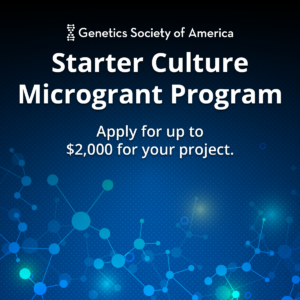The translation of nucleotide sequence into protein is a high-fidelity process that ensures the correct amino acid gets added to the nascent peptide chain. However, mutations in the translation machinery can cause amino acid mistranslation and generate defective proteins. The effects of mistranslation vary with type of amino acid substitution and the way specific amino acid substitutions affect organisms during development and aging remains poorly understood.
In this G3:Genes|Genomes|Genetics study, Isaacson et al. generated new Drosophila strains containing mistranslating tRNA variants that substitute specific amino acids, and characterized their effects on the organism’s development and lifespan.
Answering new questions requires new tools
Issacson et al. first integrated a mutant tRNASerUGA gene with the anticodon changed to AAC or AGT into flies, creating two strains with tRNASer variants that misincorporated serine at either valine (V→S) or threonine codons (T→S), respectively. Using mass spectrometry for proteomic analysis, the researchers determined the frequency of V→S and T→S mistranslations at pupal and adult stages.
While the mistranslation frequency was higher for T→S than V→S in pupae, flies in adulthood showed overall lower T→S and V→S mistranslation frequencies compared to the pupal stage. Further, T→S females mistranslated significantly more than T→S males, suggesting that mistranslation frequencies vary by developmental stage and sex.
Characterizing the effects of mistranslation
To understand the physiological effects of mistranslating variants, Isaacson and the team performed a comprehensive characterization of fly strains from the development stage to throughout adulthood and aging. Both tRNASer variants caused developmental delays and lethality while significantly fewer individuals hatched and eclosed compared to controls. Measuring the development time revealed that T→S flies took significantly longer to pupate and eclose whereas V→S individuals took longer to reach all life stage transitions compared to control flies. Additionally, homozygous flies poorly tolerated mistranslation and failed to reach adulthood resulting in the majority of adult survivors being heterozygotes.
In addition to development time delays, V→S and T→S mistranslations caused severe morphological deformities in wings, legs, and tergites. Females showed more deformities than mistranslating males and control females, indicating that females are more susceptible to the proteotoxic effects of mistranslation during development.
The researchers also found that both V→S and T→S mistranslations extended lifespan in adult females despite more morphological defects and higher rate of mistranslation compared to males. Longer living females performed better than controls in negative geotaxis or climbing assays, a commonly-used measure of neurodegeneration in Drosophila. Additionally, older females did not show any visible signs of neurodegeneration in their eyes, another method to quantify neurodegeneration. The climbing performance combined with the absence of a rough eye phenotype allude to potential neuroprotective effects of mistranslation in aging female flies.
Collectively, this study examines in detail how a single amino acid error can affect an animal’s growth and survival in a sex-specific manner. Moreover, the effects of mistranslations vary in severity at different developmental stages, with potentially beneficial effects.
References
Mistranslating tRNA variants have anticodon- and sex-specific impacts on Drosophila melanogaster
Joshua R. Isaacson, Matthew D. Berg, Jessica Jagiello, William Yeung, Brendan Charles, Judit Villén, Christopher J. Brandl, Amanda J. Moehring
G3: Genes|Genomes|Genetics. December 2024. 14(12).































